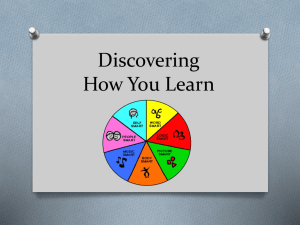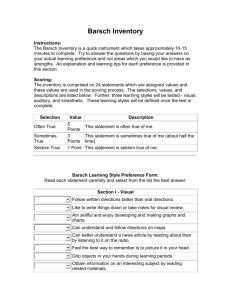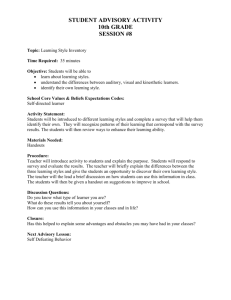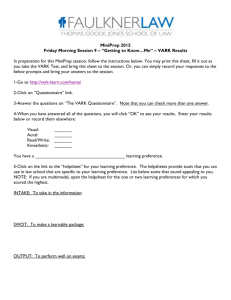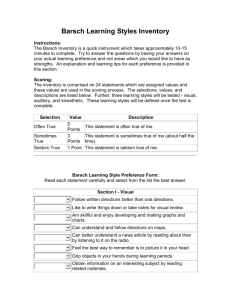Learning Styles Adopted by Medical Students
advertisement
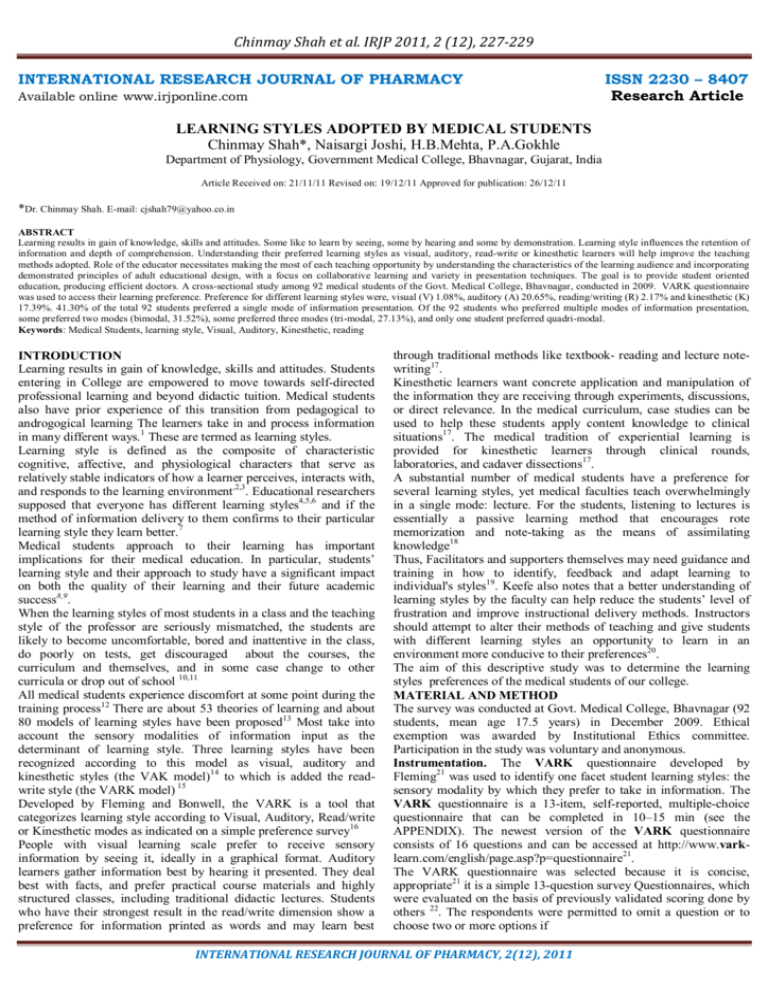
Chinmay Shah et al. IRJP 2011, 2 (12), 227-229 INTERNATIONAL RESEARCH JOURNAL OF PHARMACY Available online www.irjponline.com ISSN 2230 – 8407 Research Article LEARNING STYLES ADOPTED BY MEDICAL STUDENTS Chinmay Shah*, Naisargi Joshi, H.B.Mehta, P.A.Gokhle Department of Physiology, Government Medical College, Bhavnagar, Gujarat, India Article Received on: 21/11/11 Revised on: 19/12/11 Approved for publication: 26/12/11 *Dr. Chinmay Shah. E-mail: cjshah79@yahoo.co.in ABSTRACT Learning results in gain of knowledge, skills and attitudes. Some like to learn by seeing, some by hearing and some by demonstration. Learning style influences the retention of information and depth of comprehension. Understanding their preferred learning styles as visual, auditory, read-write or kinesthetic learners will help improve the teaching methods adopted. Role of the educator necessitates making the most of each teaching opportunity by understanding the characteristics of the learning audience and incorporating demonstrated principles of adult educational design, with a focus on collaborative learning and variety in presentation techniques. The goal is to provide student oriented education, producing efficient doctors. A cross-sectional study among 92 medical students of the Govt. Medical College, Bhavnagar, conducted in 2009. VARK questionnaire was used to access their learning preference. Preference for different learning styles were, visual (V) 1.08%, auditory (A) 20.65%, reading/writing (R) 2.17% and kinesthetic (K) 17.39%. 41.30% of the total 92 students preferred a single mode of information presentation. Of the 92 students who preferred multiple modes of information presentation, some preferred two modes (bimodal, 31.52%), some preferred three modes (tri-modal, 27.13%), and only one student preferred quadri-modal. Keywords: Medical Students, learning style, Visual, Auditory, Kinesthetic, reading INTRODUCTION Learning results in gain of knowledge, skills and attitudes. Students entering in College are empowered to move towards self-directed professional learning and beyond didactic tuition. Medical students also have prior experience of this transition from pedagogical to androgogical learning The learners take in and process information in many different ways.1 These are termed as learning styles. Learning style is defined as the composite of characteristic cognitive, affective, and physiological characters that serve as relatively stable indicators of how a learner perceives, interacts with, and responds to the learning environment,2,3. Educational researchers supposed that everyone has different learning styles4,5,6 and if the method of information delivery to them confirms to their particular learning style they learn better.7 Medical students approach to their learning has important implications for their medical education. In particular, students’ learning style and their approach to study have a significant impact on both the quality of their learning and their future academic success8,9. When the learning styles of most students in a class and the teaching style of the professor are seriously mismatched, the students are likely to become uncomfortable, bored and inattentive in the class, do poorly on tests, get discouraged about the courses, the curriculum and themselves, and in some case change to other curricula or drop out of school 10,11 All medical students experience discomfort at some point during the training process12 There are about 53 theories of learning and about 80 models of learning styles have been proposed13 Most take into account the sensory modalities of information input as the determinant of learning style. Three learning styles have been recognized according to this model as visual, auditory and kinesthetic styles (the VAK model)14 to which is added the readwrite style (the VARK model) 15 Developed by Fleming and Bonwell, the VARK is a tool that categorizes learning style according to Visual, Auditory, Read/write or Kinesthetic modes as indicated on a simple preference survey16 People with visual learning scale prefer to receive sensory information by seeing it, ideally in a graphical format. Auditory learners gather information best by hearing it presented. They deal best with facts, and prefer practical course materials and highly structured classes, including traditional didactic lectures. Students who have their strongest result in the read/write dimension show a preference for information printed as words and may learn best through traditional methods like textbook- reading and lecture notewriting17. Kinesthetic learners want concrete application and manipulation of the information they are receiving through experiments, discussions, or direct relevance. In the medical curriculum, case studies can be used to help these students apply content knowledge to clinical situations17. The medical tradition of experiential learning is provided for kinesthetic learners through clinical rounds, laboratories, and cadaver dissections17. A substantial number of medical students have a preference for several learning styles, yet medical faculties teach overwhelmingly in a single mode: lecture. For the students, listening to lectures is essentially a passive learning method that encourages rote memorization and note-taking as the means of assimilating knowledge18 Thus, Facilitators and supporters themselves may need guidance and training in how to identify, feedback and adapt learning to individual's styles19. Keefe also notes that a better understanding of learning styles by the faculty can help reduce the students’ level of frustration and improve instructional delivery methods. Instructors should attempt to alter their methods of teaching and give students with different learning styles an opportunity to learn in an environment more conducive to their preferences20. The aim of this descriptive study was to determine the learning styles preferences of the medical students of our college. MATERIAL AND METHOD The survey was conducted at Govt. Medical College, Bhavnagar (92 students, mean age 17.5 years) in December 2009. Ethical exemption was awarded by Institutional Ethics committee. Participation in the study was voluntary and anonymous. Instrumentation. The VARK questionnaire developed by Fleming21 was used to identify one facet student learning styles: the sensory modality by which they prefer to take in information. The VARK questionnaire is a 13-item, self-reported, multiple-choice questionnaire that can be completed in 10–15 min (see the APPENDIX). The newest version of the VARK questionnaire consists of 16 questions and can be accessed at http://www.varklearn.com/english/page.asp?p=questionnaire21. The VARK questionnaire was selected because it is concise, appropriate21 it is a simple 13-question survey Questionnaires, which were evaluated on the basis of previously validated scoring done by others 22. The respondents were permitted to omit a question or to choose two or more options if INTERNATIONAL RESEARCH JOURNAL OF PHARMACY, 2(12), 2011 Chinmay Shah et al. IRJP 2011, 2 (12), 227-229 The questionnaire included a covering letter explaining the purpose of the survey as well as supplemental reference materials suggesting optimal study strategies based on the learning preference scores. The consent forms and questionnaires were given to students who indicated interest in taking part in the study. Completed questionnaires were collected after 20 minutes. Student questionnaires were scored and tabulated to determine the distribution of learning styles and practice. Analysis. Students were allowed to choose multiple answers per item to adequately describe their preferred response(s) to the situations presented. The total number of student responses was tallied for each of the four sensory modalities (V, A, R, and K) and for all possible combinations of the modalities (e.g., VA, VRK, etc.). The scoring algorithm on the VARK website was then applied to identify each student's modality preferences. RESULT Total 92 students out of which 46 were male and 46 were female. Out of the total students 41.30% students preferred unimodal while 58.69% students preferred multimodel learning style as shown in Graph I Difference in boys and girls learning style is learning styles were evaluated by VARK questionnaire and according to its final results which is shown in Table I In Unimodel learning style highest preference was given to auditory mode (50%), then to Kinesthetic (42%) & then to read (5%) & visual (3%). As shown in graph II Unimodal group was further categorized in boys and girls as shown in table II and Difference in learning style of over all students is further shown in Graph II Of the total students who preferred bimodal style (32%), Auditory and Kinesthetic was preferred by 62% Student, Reading and Kinesthetic was preferred by 14% and Auditory and Reading was preferred by 24% students. None of the Student preferred other mode In case of trimodal preference (26%), 52% student preferred Auditory, reading and kinesthetic mode, 13% preferred Visual, auditory and reading, 21% preferred visual auditory and kinesthetic while visual, reading and kinesthetic was preferred by 13% students. DISCUSSION Health professions usually require several simultaneous skills involving sensory components such as visual (i.e., deciphering graphic content in research articles), auditory (i.e., listening to patients or clients), reading-writing (i.e., reading journal articles and keeping records), and kinesthetic (i.e., learning or performing physical exams and procedures). Thus, in addition to improving their academic performance, knowledge of learning theory may help students become aware of and develop ways to master these lifelong professional skills. As an educator it is important to know the preferred learning mode of the student It helps the educator identify and solve learning problems among students, thus making them more effective learner. Knowing students' preferred learning style also helps to overcome the predisposition of many educators to treat all students in a similar way. In the present study 58.65% student exhibited multimodality indicating that student use a combination of learning style, these finding are in accordance with other studies that have used VARK questionnaire as a learning style. Student who prefer Multimodal learning style do not learn by simply sitting in a classroom listening to the educator, memorizing assignments. Thus, teaching should be multisensory and filled with variety. Students are able to learn effectively as long as the teacher provides a blend of visual, auditory, reading/writing and kinesthetic activities. To achieve this goal, it becomes important to use active learning strategies. With active learning strategies, which includes teaching visual learners by the presence of models and demonstrations. Auditory learners by discussion during peer instruction, collaborative testing, debate, games, and answering questions. Manipulating models and role playing satisfies kinesthetic and tactile learners. Active learning strategies promote thinking through reasoning and improve problem-solving and decision-making skills. No specifically significant gender difference was observed in selecting unimodal or multimodal learning style which was consistent with study done by Zeynep B. Both Male and Female preferred multimodal learning style. In Unimodal learning style girl preferred auditory learning style over other styles while boys showed equal preference for auditory and kinesthetic learning style. This difference may be attributed to males being more focused externally and females being more introspective and self critical. It was interesting to note that of the six possible bimodal combinations (VA, VR, VK, AR, AK, and RK),only one combination was represented in the female student population INTERNATIONAL RESEARCH JOURNAL OF PHARMACY, 2(12), 2011 Chinmay Shah et al. IRJP 2011, 2 (12), 227-229 AK(N=16) in contrast to male who represented three combinations AK (n= 10), RK (n= 1) and AR (n = 2). Of the four possible trimodal combinations (VAR, VAK, VRK, and ARK), three were represented in the female student population VAK (n=2), VRK (n=1), and ARK(n=5), where as all four were represented in the male population (VAR(n=13), VAK(n=3), VRK(n=2), and ARK(n=10) This does not suggest that there are innate differences in aptitude between genders nor it promotes separation of gender in learning process, this actually support mix gender classrooms allowing both gender with equal opportunity to learn from each other as suggested by Lie et al It was seen in this study that in unimodal none preferred visual as learning style, even in bimodal style, in combination with other learning style also visual mode was not preferred. In trimodal also visual mode is least preferred as seen by Latha Rajendra Kumar It may be difficult at times to tailor coursework to the individual learning styles of each student. However, in these situations, by being aware of their learning style, the students may contribute to their academic success by promoting self-awareness and their use of learning strategies that work for their learning style CONCLUSION Learning style preference was examined in this study of differences among medical students and found to have significant differences in multimodal learning style, visual learning and kinesthetic learning. Awareness of student learning style and personality type could provide a basis for instructors to optimize teaching methods for diverse student populations. Learning style diversity, when properly understood by both students and educators, can be converted into appropriate teaching and learning methods that enable more students to attain success. Limitations The VARK self-reported questionnaire has not been statistically validated, and this represents a limitation to this study. Educational investigators have not been able to find a satisfactory statistical method to validate the four-factor model that is the basis of VARK Future Directions Several issues still need to be addressed. In particular, does learning style preference correlate with performance? Does student knowledge of their learning style allow them to perform better by adapting the information to their own preferred modality while studying or by finding study partners that can present the material in an alternative manner? Do K-style learners have the advantage in hands-on laboratory courses? Do A-style learners excel in the standard lecture format? REFERENCES Claxton CS, Murrell PH. (1987) Learning Styles. Washington, DC: George 1. Washington University. 2. Bedford TA. Learning Styles: a Review of Literature [1st draft]. Toowoomba, Australia: OPACS, The University of Southern Queensland; 2006. 3. Karagiannidis C, Sampson D. Adaptation rules relating learning styles research and learning objects meta-data. Proceedings of 3rd International Conference on Adaptive hypermedia and Adaptive Web-based Systems; 2004;Indhoven, Netherlands. Collins J. Education techniques for lifelong learning. Radiographics 2004; 24: 4. 1484-9. 5. Murphy RJ, Gray SA, Straja SR, Bogert MC. Student learning preferences and teaching implications. J Dental Educ 2004;68: 859-66. 6. Winn JM, Grantham VV. Using personality type to improve clinical education effectiveness. J Nucl Med Technol 2005; 33:210-3. Sadler-Smith E, Smith PJ. Strategies for accommodating individuals' styles and 7. preferences in flexible learning programs; Brit J Educ Technol 2004;35:395-12. Newble DI, Gordon MI. The learning style of medical students. Med 8. Educ.1965; 19(1):3–8 9. Mansouri P, Soltani F, Rahemi S, Nasab MM, Ayatollahi AR, Nekooeian AA. Nursing and midwifery students’ approaches to study and learning. J Adv Nurs 2006 ; 54(3):351–358 10. R.M. Felder and L.K. Silverman, Learning and teaching styles in engineering education, Eng. Educ.,200; 78(1), pp 674-681 11. R.M. Felder, Matters of style, ASEE prism,6(4), 1996; pp 18-23 12. Dyrbye, L. N., Thomas, M. R. & Shanafelt, T. D. Medical student distress: Causes,consequences, and proposed solutions. Mayo Clinic Proceedings, 2005; 80(12), 1613-1622. 13. Myers IB, McCaulley MH. Manual: A guide to the development and use of the Myers-Briggs Type Indicator. Palo Alto, C.A.: Consulting Psychologists Press. 1985. 14. Eicher, J Making the message clear. Santa Cruz, CA: Grinder, DeLozier, and Assoc. 1987 15. Fleming ND.Teaching and Learning Styles: VARK strategies.Christchurch, New Zealand: N.D. Fleming. 2001. 16. Fleming, N. D., & Mills, C.. Not Another Inventory, Rather a Catalyst for Reflection. To Improve the Academy, 1992.11, 137-143. 17. Mary Johnson, Evaluation of Learning Style for First Year Medical Students, International Journal for the Scholarship of Teaching and Learning http://www.georgiasouthern.edu/ijsotl Vol. 3, No. 1 January 2009; P. 1-15 18. Endorf, M. & McNeff, M. The adult learner: five types, Adult Learning, 1991 ; 27, pp. 20–25. 19. Smith PJ. Learners and their workplaces: towards a strategic model of flexible delivery of training in the workplace J Vocat Educ Training 2001;53:609-28. 20. Keefe, J.W. Learning style: theory and practice, Reston, VA, National Association of Secondary School Principals. 1987 21. Fleming N. VARK: a Guide to Learning Styles [online]. [Cited 2007 Mar 12] Available from : URL :http://www.vark-learn.com/ documents/TheVARK Questionnaire.pdf 22. Dýnakar C, Adams C, Brýmer A, Sýlva MD. Learning preferences of caregivers of asthmatic children. J Asthma 2005; 42: 683–7. 23. Fleming ND. I'm different; not dumb. Modes of presentation VARK in the tertiary classroom. In: Research and Development in Higher Education, edited by Zelmer A. Proceedings of the 1995 Annual Conference of the Higher Education and Research Development Society of Australasia , 1995;18: 308– 313. 24. Latha Rajendra Kumar1, K.Voralu1, S.P. Pani1, K.R. Sethuraman, Predominant Learning styles adopted by AIMST University students in Malaysia: South East Asian Journal of Medical Education, 2009; Vol. 3 no. 1, 37-46 Source of support: Nil, Conflict of interest: None Declared INTERNATIONAL RESEARCH JOURNAL OF PHARMACY, 2(12), 2011



